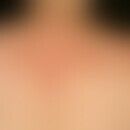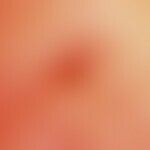Synonym(s)
DefinitionThis section has been translated automatically.
Sting by insects. For the special features of the individual sting reactions, see below Mosquito bite, bee bite, wasp bite, hornet bite, horsefly bite, flea bite.
ClassificationThis section has been translated automatically.
- Acute, toxic
- Allergic (with acquired hypersensitivity) see below Insecticide allergy
- Chronic, granulomatous with transition to fibrosing dermatitis ( dermatofibroma)
- Pseudolymphomatous reaction.
You might also be interested in
ClinicThis section has been translated automatically.
Toxic reactions: "Normal" reaction of the (non-allergic) organism to a sting: pain, itching, wheal formation. Occasionally insect bites persist for a long time as itchy, pinhead to lentil-sized, often scratched papules. Life-threatening reactions (100-1000 stings) rarely occur after insect bites.
Unusual reactions: These are reactions whose underlying pathomechanism cannot be clearly clarified. Discussed are immune complex anaphylaxis, neuropsychogenic reactions or intolerance reactions under the picture of vasculitis, serum sickness, nephropathy or urticarial dermatitis. Necrotic or vesicular insect bite reactions are not uncommon in chronic lymphocytic leukemia.
Allergic reactions: Caused by a clearly detectable (IgE-mediated) sensitization, usually due to a previous stinging event. Allergic reactions are divided into local and systemic reactions. They play a special role in bee and wasp stings.
For the special features of the individual sting reactions, see below.:
HistologyThis section has been translated automatically.
Late stage: Superficial and deep, perivascularly oriented, predominantly lymphocytic infiltrate of varying intensity, often admixed with eosinophilic granulocytes of varying density. Epidermal reactions (spongiosis, epithelial necrosis) may be present.
Early stage (rarely examined histologically): dermal edema and variegated perivascular inflammatory pattern.
ProphylaxisThis section has been translated automatically.
For insect venom-sensitized patients, specific immunotherapy (SIT) with hymenoptera venom is a well-tolerated, highly effective prophylactic therapy measure.
Measures to avoid bee wasp stings (quoted from Rueff F. et al. 2000)
- Repellents (chemical insect repellents) offer no protection.
- Outdoor consumption of food or drinks, fruit or flower picking,
- Stay near litter bins, waste bins, animal enclosures or
- Avoid fallen fruit and the use of perfume or perfumed cosmetics.
- Wash hands and wipe mouth after eating.
- Do not drink from bottles or cans, cover drinking glasses, use drinking straws.
- Do not scare insects away from food sources, especially not with hectic movements.
- Keep the skin largely covered by clothing (at least when gardening). Do not walk barefoot, do not wear open shoes.
- When riding a motorbike, wear a helmet, gloves and motorcycle clothing close to the skin. Open bicycle helmets must be provided with a net.
- Be especially careful on days with hot and humid weather, as the insects are aggressive in such weather.
- Loose fitting, light clothing and dark colours are unfavourable, light colours are preferable.
- Keep apartment windows closed during the day or secure them with insect nets. In the evening no light with open windows, as hornets are nocturnal and prefer light sources.
- Watch out for hidden insects (especially in bed or shoes).
- Avoid beehives or wasp nests and their catchment area.
- Nests near a permanent residence must be removed professionally (by beekeepers or fire brigade).
- Wasp traps or defensive sprays can be helpful.
- When insects approach or near the nest, hasty or beating movements are to be avoided, pull back slowly!
- Nests must not be shaken. Do not breathe into a flight hole.
- If attacked by bees or wasps, protect the head with arms or clothing. The retreat must not be hectic, but must be very slow.
- In case of a sting, cover the sting with your hand. If necessary, remove the sting as quickly as possible. Caution: To avoid squeezing out the poison sac, do not squeeze the sting with your fingers, but scrape it away with a fingernail.
LiteratureThis section has been translated automatically.
- Barzilai A et al.(1999) Insect bite-like reaction in patients with hematologic malignant neoplasms. Arch Dermatol 135: 1503-1507.
Kim JE et al. (2018) Insect Bite-Like Reaction with Bullous Lesions Mimicking Bullous Pemphigoid in a Patient with Chronic Lymphocytic Leukemia. Ann Dermatol 30:468-472.
Ruëff F et al. (2000) Diagnosis and therapy of bee and wasp venom allergy. Position paper of the German Society of Allergology and Clinical Immunology. Allergo J 9: 458-472.
Incoming links (27)
Actus; Allii cepae bulbi; Althaeae folium; Arnicae flos; Arthropods; Balloon vine; Bubbles; Chlorophenoxamine; Cholinstearate; Cinchocaine; ... Show allOutgoing links (25)
Acetic acid alumina; Aloe barbadensis; Arnicae flos; Balloon vine; Bee sting; Brake stitch; Bullous Pemphigoid ; Caryophilli flos; Chronic lymphatic leucemia, skin manifestations; Cross-tape; ... Show allDisclaimer
Please ask your physician for a reliable diagnosis. This website is only meant as a reference.






















